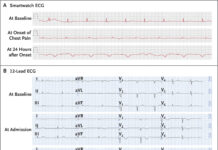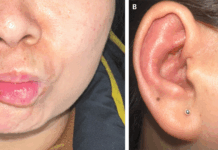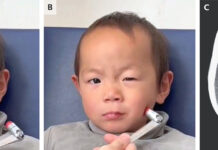Case of Behcet’s disease in 44-year-old patient with clinical presentation of papulopustular rash
A 44-year-old woman presented to the emergency department complaining of a papulopustular rash that had been present for one week. The rash had first emerged on her face and then spread to her lower legs. She also complained about ankle pain and odynophagia. Her medical history revealed that she had suffered from recurring bouts of mouth ulcers in the previous few years. She’d never experienced vaginal ulcers before. A papulopustular rash was seen on the patient’s face (Panel A) and lower legs during physical examination. When the patient lifted her lip, aphthous ulcers were visible on the inner lips and gingiva (Panel B). Ophthalmologic examination revealed no uveitis or retinal vasculitis. Antinuclear antibody, antineutrophil cytoplasmic antibody, HIV, syphilis, herpes simplex virus, and pregnancy tests all came back negative. The patient’s condition was secondary to Behcet’s disease.
Doctors did not refer the patient for a pathergy test. A pustular lesion on the right calf exhibited focal small-vessel vasculitis, according to a skin biopsy. According to the international criteria for Behçet’s disease, a diagnosis of probable Behçet’s disease was obtained. As shown in this patient, the skin signs of Behçet’s disease include erythema nodosum, pseudofolliculitis, acneiform nodules, and papulopustular lesions. The patient was started on glucocorticoids and colchicine. The rash had subsided after two months of observation.
Behcet’s disease
Behçet’s disease (BD) is a chronic, relapsing, multi-systemic inflammatory disorder characterised by mucocutaneous lesions and involvement of the ophthalmic, vascular, articular, gastrointestinal, neurologic, urogenital, pulmonary, and cardiac systems. The disease’s etiopathogenesis is uncertain. Although various immunological abnormalities have been identified in BD patients, the specific mechanism of the inflammatory changes that occur remains unknown. The most likely explanation appears to be an autoimmune reaction triggered by infectious agents such as human herpes virus 1 or Streptococcus species in genetically susceptible individuals, with vasculitis as the primary pathologic process.
The diagnosis of BD is mostly reliant on clinical criteria due to the lack of a broadly recognised pathognomonic laboratory test. Several sets of diagnostic criteria have been utilised, and all of them place a strong emphasis on mucocutaneous symptoms, specifically oral ulcers (OU), genital ulcers (GU), cutaneous vasculitic lesions, and pathergy response.
BD often manifests itself in the third decade of life and follows a chronic course with unpredictable exacerbations and remissions. However, the disease is a universal disorder with a very variable prevalence of 80-370 per 100,000 in Turkey, with 80 per 100,000 in the European part of Turkey, 150 per 100,000 in the Ankara region, and 370 per 100,000 in the North-Eastern part of Turkey, 14-20 per 100,000 along the Silk Route and possibly within 100 kilometres on either side but very low elsewhere in Asia, and 30 per 100,000 in Northern Japan (Hokkaido region) but only 1 per 100,000 in Southern Japan (Kyushu region).
In Europe and the United States, the figure ranges from 0.1 to 7.5 per 100,000. The gender distribution is fairly even. In contrast to early claims of male predominance from Turkey10 and Japan11, the male-to-female ratio has declined dramatically in the last 20 years, with the exception of Arab countries where male predominance persists. This is most likely due to the fact that in strict Muslim countries, male doctors are not permitted to examine women, and there aren’t many female doctors. Women are more likely to present as patients in doctors’ offices in several Western societies, regardless of diagnosis. Male sex, beginning at a younger age, and HLA B51 positive in BD are all associated with a more severe condition.
Clinical presentation
Mucocutaneous lesions are the disease’s distinguishing feature. The prevalence of OU, GU, and cutaneous lesions at any stage of the disease’s progression or as onset indicators confirms the importance of these clinical aspects in the diagnosis. The most common clinical symptoms of the disease in all nations are OU (92-100%), GU (57-93%), cutaneous lesions (38-99%), and ocular lesions (29-100%), along with arthropathy (16-84%), which is often moderate, predominantly arthralgias, and when arthritis, often monoarticular.
In conclusion, clinical lesions remain the most essential criteria for BD diagnosis, and it is critical to consider the potential of BD when confronted with recurring OU, GU, or other cutaneous lesions. Because patients with BD have a high prevalence of vital organ involvement as well as an increased mortality, particularly in young male patients, constant surveillance is required in these instances. In this regard, patient-centered organisations affiliated with knowledgeable physicians should be supported. With recent improvements in understanding the biology of the underlying disease and the availability of a diverse range of treatment medicines, it is now possible to alleviate most symptoms, control the disease, and maybe modify its trajectory.
Source: NEJM




